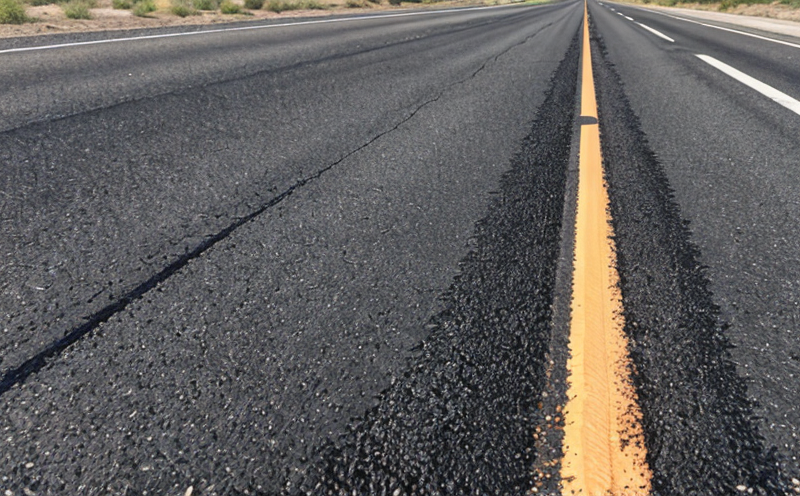ASTM D5404 Dynamic Shear Rheometer Testing
The Building & Infrastructure Testing sector encompasses a wide range of services designed to ensure the durability, safety, and compliance of construction materials. Within this sector lies the critical service of ASTM D5404 Dynamic Shear Rheometer (DSR) Testing. This method is particularly important in the realm of asphalt and pavement testing, where it plays a pivotal role in evaluating the performance characteristics of bituminous materials under varying conditions.
The ASTM D5404 test measures the viscoelastic properties of asphalt mixtures, which are essential for understanding their behavior under dynamic loading. This is especially crucial during construction and maintenance phases to ensure that pavements can withstand traffic loads without excessive deformation or failure.
Dynamic Shear Rheometer testing provides insights into the following key parameters:
- Modulus: The ratio of stress to strain in a material. Higher modulus indicates stiffer materials, which may be more resistant to deformation but also more prone to cracking under fatigue.
- Damping Ratio: A measure of the energy dissipation during deformation cycles. Lower damping ratios indicate less internal friction and potentially better resistance to fatigue failure.
- Phase Angle: Indicates the time lag between stress application and strain response, providing information on the material's viscoelastic behavior.
The test is conducted by applying a sinusoidal shear stress waveform to the sample in a controlled environment. The specimen, typically an asphalt mixture, is subjected to varying frequencies and temperatures, simulating real-world conditions such as traffic loads and ambient temperature fluctuations. This allows for the evaluation of how these factors affect the performance of the material.
The results from ASTM D5404 testing are used by quality managers, compliance officers, and R&D engineers to ensure that materials meet specified standards and perform optimally in various environments. For procurement teams, this service helps in selecting suppliers who provide high-quality products that can withstand harsh conditions over the lifecycle of a project.
The test is governed by ASTM D5404, which provides detailed guidelines on specimen preparation, testing procedures, and data interpretation. Compliance with these standards ensures reliability and consistency across different laboratories, making it easier to compare results from various sources.
Scope and Methodology
The scope of ASTM D5404 Dynamic Shear Rheometer Testing is focused on evaluating the viscoelastic properties of bituminous materials, particularly asphalt mixtures. The methodology involves several key steps that ensure accurate and reliable results:
- Specimen Preparation: Samples are prepared according to ASTM D5404 standards. This includes cutting the mixture into cylindrical specimens with specific dimensions.
- Test Setup: Specimens are placed in a shear tester equipped with a rotating disc and a fixed plate. The setup simulates the conditions under which asphalt will be used, such as traffic loads and temperature variations.
- Data Collection: During testing, various parameters like stress, strain, frequency, and temperature are recorded. This data is analyzed to determine the material's modulus, damping ratio, and phase angle.
- Analysis and Reporting: The collected data is processed using specialized software to generate reports that summarize the test results. These reports are used by stakeholders to make informed decisions about material selection and project planning.
The methodology adheres strictly to ASTM D5404, which ensures consistency and reliability in testing procedures across different laboratories. This standardization is critical for ensuring that all tests yield comparable results, facilitating better decision-making processes within the industry.
Environmental and Sustainability Contributions
The use of ASTM D5404 Dynamic Shear Rheometer Testing in asphalt and pavement testing contributes significantly to environmental sustainability by ensuring that materials are selected based on their durability and performance under real-world conditions. This helps reduce the need for frequent maintenance and replacement, which can have a positive impact on resource consumption.
- Reduced Maintenance Costs: By selecting materials that perform well over time, the frequency of repairs is minimized, leading to lower long-term costs.
- Energy Efficiency: Asphalt pavements that are designed and constructed using this testing method can contribute to energy savings by reducing friction losses during traffic flow.
- Resource Conservation: Properly selected materials may require less aggregate and binder, leading to reduced extraction of raw materials from natural sources.
- Greenhouse Gas Emissions Reduction: Longer-lasting pavements mean fewer reconstruction projects, which can significantly reduce the carbon footprint associated with construction activities.
The testing process itself also contributes positively to sustainability by providing data that helps in optimizing material usage and production processes. This ensures that resources are used efficiently, minimizing waste and environmental impact.
Use Cases and Application Examples
The ASTM D5404 Dynamic Shear Rheometer Testing is widely used in various sectors to evaluate the performance of asphalt mixtures. Here are some key use cases:
- New Pavement Design: Engineers can use test results to design pavements that meet specific performance criteria, ensuring long-term durability and safety.
- Material Selection: Procurement teams can rely on the test results to choose suppliers who provide materials that perform well under dynamic loading conditions.
- Quality Control: Quality managers use these tests to ensure that all batches of asphalt meet the required standards before being used in construction projects.
- Maintenance Planning: Maintenance engineers can plan repair and rehabilitation projects based on test results, ensuring that resources are allocated efficiently.
One notable application example is the use of this testing method during the design phase of large-scale infrastructure projects. For instance, in urban areas where traffic loads are high, proper asphalt selection ensures that pavements can withstand these conditions without significant degradation over time.
Another example involves the rehabilitation of old roads. By using ASTM D5404 test results, engineers can determine if existing materials need to be replaced or if they can be rejuvenated through specific treatments. This approach helps in extending the life cycle of pavements and reducing the environmental impact of new construction.





